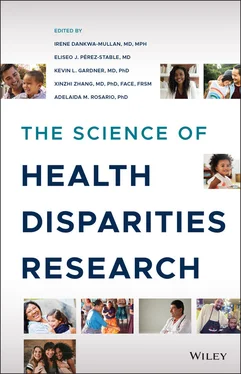Unfortunately, despite such a remarkable advance, the vigilance necessary to realize the promise embodied in this change waned. Indeed, as a long‐standing member of several established NIH study sections charged with determining the scientific merit of thousands of grant applications submitted for prospective funding, I witnessed firsthand the gradual attenuation of this policy of inclusion. Study sections struggled with its operationalization; we lacked carefully crafted examples of how adherence to this policy could be accomplished in a pragmatic fashion and thus improve our science. As a consequence, reviewers gradually drifted from a rigorous application of the policy to a pro forma determination of the adequacy of including under‐represented racial ethnic minorities, roughly equivalent to whether or not sampling plans assured their representation equal to that characteristic of the settings in which this work was to be conducted. One seldom read arguments, for example, for oversampling special populations in a manner that would truly test the hypotheses underpinning the proposed research, and thereby address race, ethnicity, or disadvantage as possibly important sources of variation in the phenomena under study.
Again, numerous contributors to this volume who also served on NIH study sections shared this concern and lamented the absence of careful attention to the implications for the science. Understanding the original arguments for why, scientifically , such individuals should be included in the work sponsored by NIH gradually faded; inattention diluted the promise of this remarkable policy. Arguments for the inclusion of under‐represented racial and ethnic minorities and the disadvantaged in NIH‐sponsored research eventually shifted from the benefit to science to the underlying importance of health equity and social justice. While the latter are important motives for undertaking such work, they are, in my opinion, necessary, but not sufficient conditions for promoting knowledge acquisition and ensuring the scientific merit of such efforts.
One and one‐half decades later, the now National Academy of Medicine reviewed the NIH's strategic research plan to reduce and ultimately eliminate health disparities. This assessment essentially focused on the impact of the National Center on Minority Health and Health Disparities as of 2006, just prior to elevation to its current Institute status. In the Academy's report, the committee, of which several authors in this volume and I were members, concluded that the unfinished business of the Center and NIH was to revitalize a focus on the relevant science and to offer a coherent thematic framework for its pursuit. An emphasis on the social determinants of health emerged and gained increasing currency in anticipating and focusing this work. As the present volume amply demonstrates, this particular framework has played a critical role in organizing attention to the key domains and related constructs that bear importantly on the science underpinning minority health and health disparities research today.
This volume, and its companion piece in the special issue of the American Journal of Public Health , provide a roadmap to guide the science in this area. The chapters contained herein illustrate the importance and feasibility of systematic, rigorous inquiry for understanding the specifics of minority health and health disparities. They also convey the importance of the lessons learned for science in general: for discovery, for generalizability, for advancing theory, for enhancing measurement, for improving investigative methods, for promoting attention to neglected areas of research, and for diversifying the scientific work workforce. The Science of Health Disparities Research returns us to the spirit of 1992, and conviction, albeit now empirically demonstrable, that work of this nature can be exacting, meritorious, innovative, and broadly relevant. I applaud my colleagues' efforts in this regard and am confident those who follow can more effectively integrate health equity, social justice, and good science in service of improving the health of racial and ethnic minorities, as well as the disadvantaged, and humankind in general.
Spero M. Manson, PhD Distinguished Professor of Public Health and Psychiatry Colorado Trust Chair in American Indian Health Colorado School of Public Health University of Colorado Anschutz Medical Campus
We would like to thank all of the scientists, clinicians, and community‐based researchers who have contributed to the scientific literature on minority health and health disparities research. Their vast contributions to the field serve as the foundation for this text. We also would like to thank chapter authors for their commitment to this project and their submissions. Further, we are eternally grateful to the staff of the National Institute on Minority Health and Health Disparities for their support, suggestions, and advice that helped us refine our ideas. Finally, we extend special thanks to Ligia Artiles and Richard C. Palmer for the immeasurable support they provided in successful completion of this project.
1 Definitions, Principles, and Concepts for Minority Health and Health Disparities Research
Eliseo J. Pérez‐Stable1, Jennifer Alvidrez1, and Carl V. Hill2
1 National Institute on Minority Health and Health Disparities, National Institutes of Health, Bethesda, MD, USA
2 Office of Special Populations, National Institute on Aging, National Institutes of Health, Bethesda, MD, USA
In 1985, Department of Health and Human Services (DHHS) Secretary Margaret Heckler commissioned a report on minority health at the urging of African American health leaders. The Heckler Report on Black and minority health examined the health status of Americans by race/ethnicity and identified the gaps in disease rates, mortality, and other outcomes among Blacks compared to Whites [1]. The report provided a foundation for the scientific field of minority health research and legitimized a perspective that had been developing for several decades. At the time, the public health paradigm was to evaluate health differences in populations from a socioeconomic perspective and access to care on the assumption that these were the main drivers of health outcome differences. The Heckler Report introduced the notion at a national level that race and ethnicity may be an independent contributor to health outcomes, which merited scientific study and targeted intervention programs. In 1987, the DHHS Office of Minority Health was founded, led by Herb Nickens, MD.
In 1990, the Office of Minority Programs was founded at the National Institutes of Health (NIH) under DHHS Secretary Louis Sullivan, MD. In 1993 the name was changed to the Office of Minority Health Research. Through congressional legislation, this office was transformed in 2000 into the Center on Minority Health and Health Disparities, and in 2010 to the National Institute on Minority Health and Health Disparities (NIMHD). John Ruffin, PhD was the director from 1990 until his retirement in 2014. 1
In 1999, DHHS Deputy Secretary David Satcher, MD cited the unacceptability of demonstrated healthcare disparities by race in commenting on a study published in the New England Journal of Medicine, showing that Blacks were less likely to be referred for cardiac evaluation when presenting with classic chest pain symptoms compared to Whites [2]. Two years later, the Institute of Medicine (IOM) published the Unequal Care report summarizing a legacy of unequal healthcare and more adverse results for most leading causes of death and disability in the United States among African Americans compared to Whites [3]. Remarkably, little data were contained in this Report about the status of other race/ethnic groups in the United States. The IOM report broke down silos and provided the field with unifying principles about healthcare disparities. These events brought together scientific disciplines from population health, social science, and clinical care to focus on minority health and health disparities research.
Читать дальше












